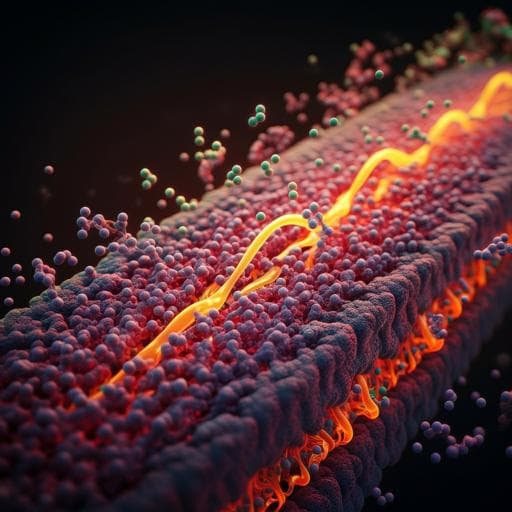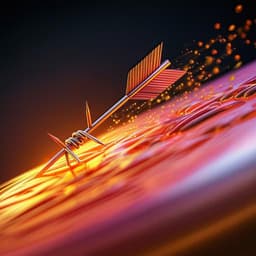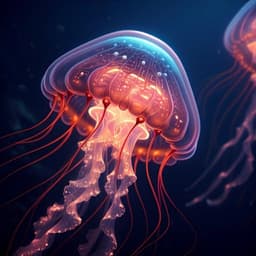
Engineering and Technology
Shielding effect enables fast ion transfer through nanoporous membrane for highly energy-efficient electrodialysis
J. Lin, W. Ye, et al.
Discover how a groundbreaking thin-film composite nanoporous membrane enhances electrodialysis for sustainable wastewater management. This innovative research by Jiuyang Lin, Wenyuan Ye, Shuangling Xie, and colleagues showcases unprecedented efficiency in separating organics and NaCl while minimizing fouling, opening new pathways in mass transport mechanisms.
~3 min • Beginner • English
Introduction
The study addresses the challenge of selectively fractionating organics and inorganic salts (NaCl) from saline organic-rich wastewaters to enable resource recovery. Conventional nanofiltration (pressure-driven) suffers from high osmotic pressure, fouling, and cake-enhanced concentration polarization, reducing flux and separation efficiency, while electrodialysis with commercial anion exchange membranes (AEMs) experiences fouling due to attraction of negatively charged organics to positively charged fixed sites, limiting anion transfer and fractionation. The authors propose an electro-driven system that replaces AEMs with thin-film composite nanoporous polyamide membranes engineered via dopamine/polyethyleneimine (PDA/PEI) co-deposition to create anion-conducting membranes (ACMs). The hypothesis is that tuning surface charge and pore structure will intensify charge shielding, reduce electrostatic barriers for anion transport, and provide nano-channels and size-exclusion to retain organics, enabling fast anion transfer and highly efficient, low-fouling electrodialytic fractionation.
Literature Review
Background highlights include: nanofiltration membranes (MWCO 200–1,000 Da) separate organics and salts via size exclusion and electrostatic effects but suffer from flux decline due to fouling and osmotic pressure; diafiltration requires large volumes of pure water and leads to loss of target organics. Electrodialysis is effective for desalination but AEMs foul in the presence of negatively charged organics, reducing anion transfer. Polydopamine-based surface coatings offer a versatile, scalable strategy for membrane surface modification and hydrophilicity enhancement, but prior applications have focused mainly on pressure-driven processes; there are limited reports of PDA-coated nanoporous membranes used in electro-driven separations. The study builds on these insights to design PDA/PEI co-deposited TFC membranes as ACMs, leveraging reduced negative surface charge and tailored pore size for improved anion conductivity and organic retention.
Methodology
Materials: A loose poly(piperazine amide) thin-film composite nanoporous membrane (LNFM-1, MWCO 682 ± 17 Da) served as substrate. Commercial CEM (CJMC-3) and AEMs (AEM-1: AEM-N1; AEM-2: TWEDA1R70; AEM-3: FAS-30; AEM-4: FAS-PET-130; AEM-5: Neosepta AMX) were used for comparison. Model organics: ceftriaxone sodium (MW 598.5 Da), cefotaxime sodium (MW 477.5 Da), carbenicillin disodium (MW 422.4 Da), ampicillin sodium (MW 371.4 Da). Salts: NaCl; electrolyte: Na2SO4.
Membrane fabrication (mussel-inspired coating): The substrate was placed in a mold. Dopamine HCl (2.0 g l−1) and PEI (2.0 g l−1, MW 600 Da) were dissolved in 50 mmol l−1 Tris buffer at pH 8.5. Co-deposition durations: 0, 6, 12, 18, 24, 30, 36 h, yielding NPM-0 to NPM-6. Coating mechanism confirmed by XPS (Schiff base/Michael addition). Morphology and thickness characterized by SEM and AFM.
Characterization: Hydrophilicity (OSA200 contact angle), surface charge (zeta potential; SurPASS in 10 mM NaCl, pH 6.7), specific areal electric resistance (custom 4-compartment cell in 0.5 M NaCl), pore size/MWCO (PEG rejection series). Layer thickness measured by AFM; SEM for surface/cross-section.
Pressure-driven tests: Cross-flow nanofiltration at 4 bar, 25 ± 1 °C (effective area 22.9 cm²). Tested pure NaCl solutions (1.0–12.0 g l−1), individual antibiotics (1.0 g l−1), and antibiotic/NaCl mixtures (antibiotic 1.0 g l−1 + NaCl up to 12 g l−1). Rejection R = (Cf − Cp)/Cf. Selectivity S between Cl− and antibiotics: S = (1 − RNaCl)/(1 − Rorganics). Constant-volume diafiltration on NPM-6 with 300 ml feed (1.0 g l−1 antibiotic + 12 g l−1 NaCl); diavolume n used to maintain feed volume; tracked desalination β and antibiotic recovery α.
Electro-driven (electrodialysis) tests: Custom ED cell with cathode/anode and stack of 3 CEMs and 2 membranes (either PDA/PEI-coated NPMs as ACMs or commercial AEMs), effective area 19.4 cm² per coupon. Electrolyte: 0.3 M Na2SO4 in electrode chambers. Pure NaCl feed (300 ml, ~12 g l−1) tested at 0.5 A until feed conductivity reached 0.16 mS cm−1. Energy consumption E = ∫(U·I·dt)/[(Cinitial,NaCl − Cfinal,NaCl)·V·M]; desalination efficiency γ = 1 − Cfinal,NaCl/Cinitial,NaCl. Antibiotic/NaCl mixtures (300 ml; 1.0 g l−1 antibiotic + 12 g l−1 NaCl) processed at 0.5 A until feed conductivity <0.2 mS cm−1; recovery δ = 1 − Cfinal,organics/Cinitial,organics; permselectivity P defined as ratio of normalized transfers per equation (8). Long-term stability: 18-cycle ED with ceftriaxone sodium/NaCl using NPM-6; comparison: 12-cycle ED with commercial AEM-5. High-salinity test: humic acid/NaCl (1.0 g l−1 HA + 50 g l−1 NaCl) at 0.8 A for four cycles with NPM-6 vs AEM-5.
MD simulations: All-atom MD domain comprising PDA/PEI layer with nanochannels; ions (Cl−, Na+, ampicillin) and water subjected to an applied electric field. Drift velocities sampled every 200 fs over last 15 ns; three independent runs. Simulations tracked ion movements relative to field direction to elucidate transport mechanisms and charge shielding effects.
Key Findings
- PDA/PEI co-deposition successfully and uniformly coated the loose TFC NPM substrate, increasing selective layer thickness from 87.5 ± 8.5 nm (NPM-0) to 135.0 ± 12.6 nm (NPM-6), and reducing pore size/MWCO.
- Surface properties tuned: increased hydrophilicity; reduced negative surface charge; specific areal electric resistance decreased from 10.47 ± 0.43 Ω·cm² (NPM-0) to 5.69 ± 0.13 Ω·cm² (NPM-6), enabling higher anion conductivity.
- Pressure-driven separation: Organic rejection increased with coating duration due to reduced pore size (e.g., ampicillin sodium rejection 98.5 ± 0.2% for NPM-6 vs 88.9 ± 0.5% for NPM-0). NaCl rejection decreased with coating duration due to diminished electrostatic repulsion. In mixed feeds, NPM-6 maintained high antibiotic rejection with minimal sensitivity to NaCl concentration, increasing NaCl/antibiotic selectivity (e.g., NaCl vs ampicillin selectivity 27.4 for NPM-6 vs 5.0 for NPM-0 at 12 g l−1 NaCl).
- Pressure-driven diafiltration (NPM-6): Achieved 99.3–99.4% desalination after ~5.9–6.0 diavolumes, but incurred antibiotic losses: 4.18% (ceftriaxone), 6.27% (cefotaxime), 8.98% (carbenicillin), 11.47% (ampicillin), indicating productivity loss and water use burden.
- Electrodialysis with PDA/PEI-coated NPMs (as ACMs): For pure NaCl (~12 g l−1), NPM-6 achieved 99.5% desalination with energy consumption 5.86 ± 0.10 kWh kg−1 within 124 min; performance comparable to commercial AEMs.
- One-step fractionation of antibiotic/NaCl mixtures with NPM-6 (0.5 A): Diluate NaCl contents 0.076–0.083 g l−1; desalination efficiencies 99.30–99.36%. Antibiotic recoveries: 99.28% (ceftriaxone), 99.26% (cefotaxime), 99.21% (carbenicillin), 99.11% (ampicillin). Only trace organics (<10 ppm) detected in concentrate. Permselectivity between Cl− and antibiotics extremely high (up to 21,407 for NaCl vs ceftriaxone sodium).
- Long-term stability (18 cycles, ceftriaxone/NaCl): Nearly identical desalination in each cycle (99.3–99.4%), negligible fouling as indicated by modest increase in specific areal electric resistance; organics recovery >99.2% sustained.
- Humic acid/NaCl (50 g l−1 NaCl) with NPM-6: Desalination efficiency 99.2%; humic acid recovery 99.6–99.7% over four cycles; low fouling propensity observed.
- MD simulations corroborated mechanism: Under applied field, Cl− moved rapidly through PDA/PEI-coated nanochannels (drift velocity ~7.0 × 10−7 Å fs−1), while ampicillin ions were nearly stationary (drift velocity ~2.2 × 10−8 Å fs−1) due to size exclusion and weak field response; Na+ moved toward cathode. Results support charge shielding–enabled fast anion transfer with organic retention.
- Benchmarking vs commercial AEM-5: AEM-5 fouled over 12 cycles (ceftriaxone/NaCl), reducing desalination efficiency (98.0% → 97.5%), leaving >0.24 g l−1 NaCl in diluate, and allowing >41 mg l−1 ceftriaxone in concentrate (recovery <95.9%). With humic acid at 50 g l−1 NaCl, AEM-5 desalination dropped 98.9% → 98.6% with ~96.7% humic acid recovery, evidencing inferior fractionation and higher fouling compared with PDA/PEI-coated NPMs.
Discussion
The PDA/PEI-coated TFC nanoporous membranes, used as anion-conducting membranes in electrodialysis, directly address the core challenge of fouling-prone AEMs and inefficiencies of pressure-driven nanofiltration for saline organic-rich streams. By reducing negative surface charge and tailoring pore size, the membranes intensify charge shielding, lowering the electrostatic energy barrier for anion transport while preserving nano-scale sieving of organics. Experimentally, this dual effect yields fast, energy-efficient desalination coupled with near-complete organic retention in a single step, substantially surpassing pressure-driven diafiltration (which requires large water volumes and incurs solute losses) and outperforming commercial AEMs that foul via electrostatic attraction of anionic organics. MD simulations validate the mechanistic basis: rapid, field-driven Cl− transport through the PDA/PEI layer versus minimal drift of bulky anionic organics that are size-excluded and weakly influenced by the field. The results establish a new mass transport paradigm for electro-driven separations using surface-engineered nanoporous membranes, enabling high permselectivity and long-term stability with negligible fouling across multiple cycles and in challenging matrices (e.g., humic acid at elevated salinity).
Conclusion
This work demonstrates a facile, scalable PDA/PEI co-deposition strategy to convert loose TFC nanoporous membranes into highly anion-conducting, anti-fouling membranes for electrodialysis. The engineered membranes provide fast anion transfer via charge shielding and nanochannel transport while retaining organics by size exclusion, enabling one-step, high-efficiency fractionation of organics and NaCl with >99.3% desalination and >99.1% organic recovery, low energy consumption, and excellent multi-cycle stability. Compared to commercial AEMs, the PDA/PEI-coated NPMs show markedly reduced fouling and superior separation performance. These findings offer guidelines for designing cost-effective ACMs to retrofit conventional AEMs and advance sustainable resource recovery from complex saline waste streams. Potential future research directions include scale-up and module-level optimization, exploration of broader classes of organic contaminants and real wastewater matrices, long-term operation under varied salinities and pH, and further tuning of coating chemistry/structure to balance conductivity and selectivity.
Limitations
- Electrodialysis energy consumption and diluate quality degrade with increasing feed salinity; the process is more cost-effective at low salinity. High-salinity validation was limited to a 50 g l−1 NaCl humic acid case at higher current (0.8 A), indicating constraints at elevated salinity.
- Organic models were primarily four antibiotics (and humic acid); performance across the full spectrum of organics and real, complex wastewaters requires further validation.
- While long-term tests (18 cycles) showed low fouling, longer-duration, continuous operation and broader operating envelopes (variable pH, temperature, scaling species) were not reported.
- Comparisons to commercial AEMs emphasized AEM-5 and may not encompass all state-of-the-art AEM variants or optimized operating conditions.
Related Publications
Explore these studies to deepen your understanding of the subject.







